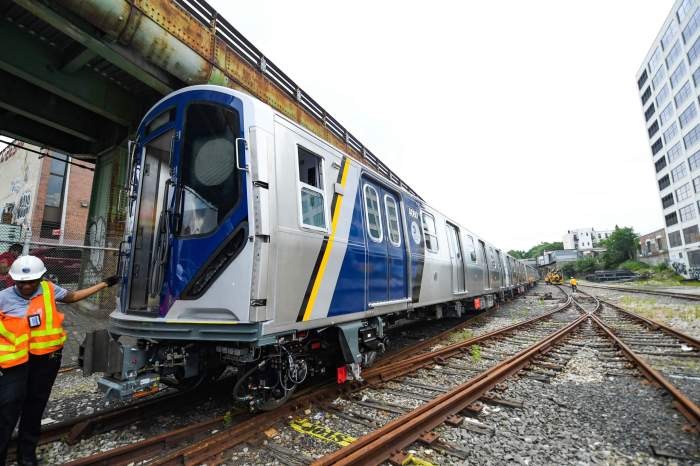
BY COLIN MIXSON | The city took the first steps toward tightening regulations of construction cranes and their operators, implementing several measures designed to prevent collapses like the one that claimed the life of David Wichs, a 38-year-old Upper West Side man, in Lower Manhattan earlier this year.
The action by the Department of Buildings (DOB) follows the recommendations of a crane-safety panel set up in the wake of the February 5 toppling of a crawler crane on Worth Street. The Crane Safety Technical Working Group reported its findings last month.
The new regulations were put into effect at the end of June by order of DOB Commissioner Rick Chandler, and may be tweaked and refined over coming weeks as they’re written into the city’s construction code, according to a spokesperson for the agency.
The new rules include:
- Requiring mobile cranes to be fitted with wind measuring devices, called anemometers, which record real-time wind readings.
- Requiring contractors to hire “on-site lift coordinators” with the authority to shutdown crane operations in the event of unsafe conditions.
- Restricting mobile crane operations whenever winds exceed 30 miles per hour.
- Requiring crane operators to secure cranes when not in use as per a specified “wind-action plan,” which includes retracted, jackknifed, and laid-down positions.
These regulations are in addition to emergency measures taken immediately after February’s crane collapse, which included banning mobile cranes rated for 20-mile-per-hour wind gusts or less from operating on public streets and an increase in fines related to “failure to safeguard cranes” from $4,800 to $10,000, both of which will remain in effect.
Furthermore, the now-mandated on-site lift coordinators will be subject to unannounced inspections, during which city sleuths will check recorded wind readings at work sites and compare them to the actions of the lift coordinators to ensure operations were shutdown in accordance with the commissioner’s mandate.
Joe Soldevere, a spokesperson for the DOB, stressed that additional regulations will likely follow, and that the new rules announced in June comprise measures that the building’s department felt could be implemented without new legislation on the part of City Council and which were simple enough to be implemented quickly.
“We will have additional actions to announce in terms of enacting the recommendations that the working group has already made,” said Soldevere, “but as the commissioner said, these regulations are solid, sensible, and doable.”
Reacting to the new crane regulations, Upper West Side City Councilmember Helen Rosenthal said, “I’m particularly pleased that all mobile cranes will now be fitted with wind measuring devices, because the wind gusts caused by canyons of tall buildings can be much stronger than what’s measured in the middle of Central Park. As the working group’s report shows, these recommendations will make New York City’s crane safety regulations some of the strictest and safest in the world — we have to get safety right.”
Rosenthal’s East Side colleague Dan Garodnick responded to the new regulations by saying, “Crane collapses are preventable, and too-often they are deadly. In the midst of our building boom, New York City must use every tool available to bring construction accidents to zero. The Department of Buildings’ new crane safety measures represent a sensible step forward in achieving this goal.”

Upper West Side City Councilmember Mark Levine is the main sponsor of Intro 420, a pending measure that would place limits on construction near schools. That measure received a committee hearing last June but has seen no action since then.
Ben Kallos, an Upper East Side councilmember, has been working on stricter regulations for construction sites since April 2014 when he proposed Intro 299, also known as the Construction Safety Act. Under the bill, workers seeking hoisting machine operator licenses would be required to have qualifying experience in New York City and complete specific examinations administered by the DOB, instead of other accredited organizations.
Kallos said while the industry is moving toward having a national standard of construction safety, New York’s landscape is unique and should have operators with distinct experience within the city.
“The key piece is to make sure the folks have training, make sure they’re certified, and make sure their training is local to New York City,” he said.
Kallos’ measure has seen no recent Council action.
While there have been no recent crane accidents on the Upper East or West Sides, there were three serious crane-related accidents throughout the borough in the two years leading up to February’s Tribeca tragedy.
According to the DOB’s accident database, a construction worker was injured when a spider crane on the roof of 353 Spring Street tipped over on February 7, 2014.
More than a year later, on May 31, 2015, city records show, seven people were injured when a crane dropped an air conditioning unit after trying to hoist it to the roof of 261 Madison Avenue between 38th and 39th Street. A Daily News story on that incident pegged the number of injuries at 10, three more than the DOB reported.
Less than a week later, on June 2, a construction worker was injured during the installation of a tower crane at 41 East 22nd Street, according to accident reports.

In 2008, two crane collapses on the Upper East Side happened less than three months apart. According to Department of Buildings accident records, an incident on March 15 of that year left seven people dead and 22 injured after a tower crane collapsed at 303 East 51st Street. Shortly afterwards, on May 30, another crane collapsed at 335 East 91st Street, leaving two dead and one injured.
The deadly February crane collapse in Tribeca isn’t the only instance of a crane toppling over in recent memory.
A crane collapse on July 19 snarled traffic on the Tappan Zee Bridge for four hours, although motorists largely escaped the crash unharmed, with only three drivers suffering “very minor” injuries, according to Governor Andrew Cuomo, who spoke at a press conference following the accident.
The collapse occurred amid a $3.9 billion project to replace the aging 1955 span, and the toppled crane was one among 28 that were installing pilings using a vibrating hammer at the time that it fell.
The governor described the fallen crane as a newer model, which had conducted heavier work than it was carrying out at the time of the accident. — Additional reporting by Jackson Chen



































